Free shipping for all orders over 30 euros!
-
Shop
- Insights
-
About ROMBO
- Dealers
- Guitar Pick finder
- Gift Card
+Categories
- accessories
- bass
- bass pick
- bass picks
- bass plectrum
- bass plectrums
- beginner
- bright tone
- chose guitar pick
- chose guitar picks
- chose plectrum
- chose plectrums
- CrystalBright
- Diamond
- Diamond pick
- discipline and guitar
- DIY generation
- durability pick
- durable pick
- eco
- ecoblack
- find guitar pick
- find plectrum
- fingers vs picks
- grip
- grip guitar pick
- guitar accessories
- guitar advantages
- guitar benefits
- guitar career
- guitar health
- guitar injury
- guitar learn
- guitar lesions
- guitar lesson
- guitar method
- guitar noise
- Guitar noise plectrum
- guitar pain
- guitar pick
- guitar pick beginner
- guitar pick bevel
- guitar pick buy
- Guitar pick diamond
- guitar pick durability
- guitar pick durable
- guitar pick eco
- guitar pick features
- guitar pick grip
- guitar pick material
- Guitar Pick Noise
- Guitar Pick online
- guitar pick recycled
- guitar pick recycled material
- guitar pick special features
- guitar pick textures
- guitar pick thickness
- guitar pick variable thickness
- guitar picks
- guitar tone
- guitar warm-up
- guitarpick
- guitarpicks
- hold a guitar pick
- hold guitar pick
- hold guitar picks
- hold pick
- hold plectrum
- hold plectrums
- how to
- how to chose your guitar picks
- jazziii
- learn guitar
- lose guitar pick
- material
- materials
- mental health and guitar
- motivation and guitar
- music
- not to lose guitar pick
- Online guitar
- online guitar pick
- online guitar pick buy
- pick
- pick durability
- pick material
- pick noise
- Picks
- picks vs. fingers
- play bass fingers
- play bass picks
- play bass with fingers
- play bass with pick
- play bass with picks
- play bass with plectrum
- play guitar faster
- plectrum
- plectrum attributes
- plectrum beginner
- plectrum bevel
- plectrum characteristics
- plectrum features
- plectrum grip
- plectrum material
- plectrum noise
- plectrum recycled
- plectrum shape
- plectrum variable thickness
- plectrums
- Plek
- pua
- recycled
- recycled guita pick material
- recycled guitar picks
- recycled picks
- recycled plectrum
- Rombo Diamond
- rombopicks
- tendonitis guitar
- the guitar pick
- tone
- variable thickness
- warm tone
- warm-up guitar

HOW OVER 2000 GUITAR PLAYERS HELPED US CO-DESIGN OUR GUITAR PICKS FOR 2023:
In June 2022, we finished the first 3D sketches of our four new guitar pick models. However, the picks weren’t 100% ready.
The thickness, size, and even the names of the picks were still undefined.
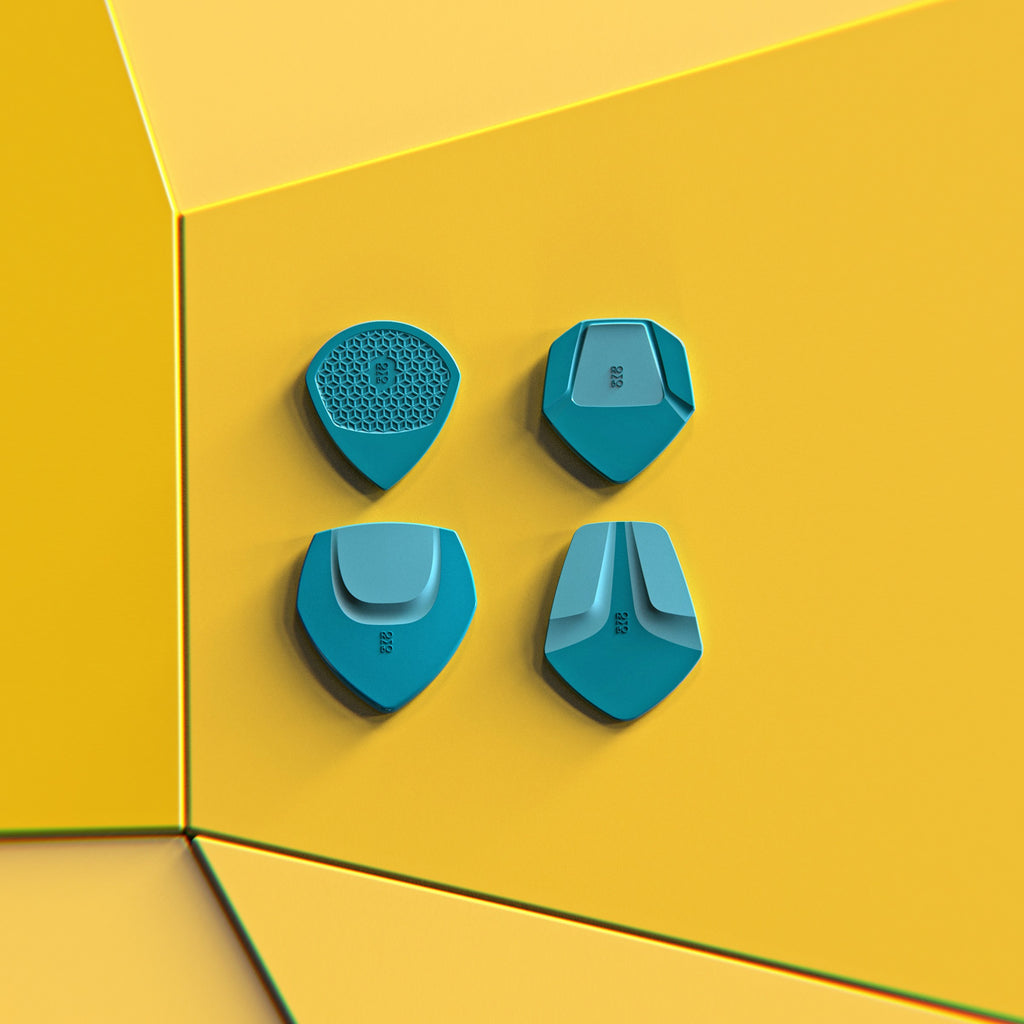
We decided to take the approach of involving as many guitarists as possible to help us co-design our new guitar picks.
The aim of this article is to summarize the results of the survey that 2122 guitarists completed. These people directly influenced the final design of our picks.

The guitar community has strongly supported Rombopicks since its beginning in 2019.
We did not want to create new guitar picks without asking the people who have been with us since the beginning. You all are the core of Rombo, and you should decide which products we develop.
The most logical step was to create a big survey, allowing users to tell us how they prefer their guitar picks. We think this is the only way to develop a product based on the wants of our users, allowing us to make essential decisions about our company's direction.

This is only possible by listening to the thoughts of every guitar player.
GUITAR PICKS 2023 - RESULTS OF THE SURVEY
2122 guitar players participated in the survey and, therefore, have taken part in the design process of these new guitar picks for 2023.
509 of them left a private message with detailed information.
We discuss these private messages below.

WHAT IS YOUR FAVORITE GUITAR PICK DESIGN?


There is a clear winner. Guitar pick number 2 is the favorite for most people.
Could it be because of its similarity in shape and size with the iconic jazz iii guitar pick?
Surprisingly, number 4 is the guitar pick that surprised me the most during the
prototype test. But of course, you never know until you try it!
GUITAR PICK NUMBER 1:

Name:
- Mosaic: 33,4%
- Pegasus: 16,6%
- Sense: 13%
- Summit: 6,8%
- Other names: 30,2%
Average Thickness: 0,66 mm
Size: Small Size with 89% of the votes
GUITAR PICK NUMBER 2:

Name:
- Shell: 42%
- Lance: 18%
- Turtle: 8,2%
- Other names: 31,8%
Average Thickness: 0,953 mm
Size: Medium Size with 77% of the votes
GUITAR PICK NUMBER 3:

Name:
- Erebus: 52%
- Quasar: 32,1%
- Jupiter: 10,1%
- Moon: 5,15%
- Other names: 0,65%
Average Thickness: >2 mm
Size: Large Size with 55% of the votes
GUITAR PICK NUMBER 4:

Name:
- Dune: 39,8%
- Lance: 31,2%
- Doppler:19,6 %
- Sense: 4,7%
- Other names: 4,7%
Average Thickness: 0,72 mm
Size: Medium Size with 85% of the votes
GUITAR PICKS: PERSONAL THOUGHTS OF 509 GUITAR PLAYERS

A total of 509 people left us a private message regarding guitar picks.
We have read all of them carefully and we will use all this information during the
development stage.
Here are the top 10 questions we have repeatedly received and our comments on them:
● Will the guitar picks be available in different colors?
Yes! The launch will include all regular Rombo colors.
Other “special edition” colors are in the pipeline.
● Will they have the same grip structure?
Lots of people have sent us e-mails and letters regarding the grip structure. With the micro-nodules, we have the advantage of medium-grip surfaces which add lots of control.
However, a very small number of people want the picks to have more grip. We had to make a decision here, and it was hard. We will slightly increase the “grain density” on the textured areas, so there are more “micro-nodules” per square millimeter.
This way, we hope to satisfy the needs of all groups.
● The material is cool but it produces warm and mellow tones. I prefer
bright tones. Do you plan a new material range?
We have intentionally created our compound in order to reach those mellow tones. However, about 12% of the users reported preferring bright tones.
We have decided to start the research on a new material that will be launched as an extra range as soon as we find the correct formula. The expected date for the launch of the new material is early 2024.
● Why don’t you create different guitar pick thicknesses for each one
of the models?
We want every guitar pick to be unique. As every person has individual preferences, we believe every guitar pick should have its own design. In the future, we hope to be able to create a wider range of plectrum designs to cover each possible necessity.
● What about picks for bass players?
Most of our picks are compatible with bass, as we have confirmed this with some bassists that are using them regularly, especially Rombo Diamond and Rombo Origami. We explained this HERE.
● You should create some merch, T-Shirts, and other stuff:
Maybe in the future. Now, we want to focus 100% on the development of the guitar picks. Every minute we spend on the design of a T-Shirt will be taken away from the quality of the picks! ;)
● Will you offer the EcoBlack range in other colors?
The EcoBlack material can only be produced in one color at the moment.
The recycling process creates a very dark pigmentation. The industry is working hard to find a way to create new recycling processes. We hope we will manufacture all of our picks out of recycled material in the future.
● Why don’t you create boutique picks?
Counter question: What is a boutique guitar pick?
A boutique pick is a unique piece of art with the shape of a guitar pick that you can use for guitar playing. Usually, these picks are handmade and out of exotic materials. They contain some artistic elements like ornament geometries and usually they are unique special edition pieces with elevated starting prices.
Our approach is different. We create boutique-like guitar pick designs at very affordable prices. Otherwise, there would only be a couple of Rombo designs available for the most influential pick collectionists.
We think, this way, we found a niche in the middle of mass production picks and single special editions. With this approach, we bring the boutique feel to a larger number of people, reinforcing the guitar pick community and the awareness of this small but important accessory.
● Some picks I ordered in 2019 had burrs. This is not a problem for
playing but it doesn’t look cool.
We have good news for you. In 2021, we developed a new method to manually remove the burrs from the picks. This means that all Rombo picks are manually revised and processed to remove all the visual aspects that don’t belong to the original design (like small burrs on the border).
This cost us extra time but as a premium brand, we need to keep improving our quality standards to make sure your guitar picks are as good as your expectations!
● Why Kickstarter again?
See below :)
WHEN WILL THE NEW PICKS BE AVAILABLE?
The new guitar picks will be launched in spring 2023.
If you want to receive an E-Mail as soon as the picks are available, join our
mailing list (see the footer).
This is the timeline we created for this project:

WHY KICKSTARTER?
Kickstarter campaigns turn dreams and ideas into reality. Rombo is still a small start-up run by two people, and with limited access to resources. Through Kickstarter, we involve the community of guitar players, showing our guitar picks before launching.
This process brings us in contact with the real guitar players. It forces us to remain flexible, accept changes, and it challenges us to create new designs to fulfill the expectations of our audience.
We love open and critical criticism, and this is the best place to get it, where all comments and thoughts are visible. By sharing your experiences, we can listen to your needs and wishes, and create guitar picks that make a difference.

Guitar Pick for Beginners
Guitar picks are one of the most useful accessories for beginners, who have just started to play the guitar or bass.
Having a guitar pick won’t make you a professional guitar player faster, but will enhance the playability of your guitar.
With the right plectrums, you can easily learn new techniques and shape your skills.

The amount of guitar pick brands available on the market today is huge. This can be overwhelming if you are a beginner guitarist, and choosing the right guitar pick can be a tough process if you start in the wrong place.
But first of all: Who is considered a beginner guitar player?
Who is Considered A Beginner Guitar Player?
A beginner guitar player could be someone who just started playing last week, or, someone who has been practicing guitar for 2 months.
It is very difficult to define a line between the beginner and intermediate stages of guitar playing. Especially when you have learned to play the guitar yourself.

In general, to be considered an intermediate player, you should know and master the following areas:
- Change smoothly between fundamental open chords.
- Know power chords and be able to move around then cleanly.
- Know the difference between major and minor basic chord shapes and sounds by hearing.
- Know the note positions on the fretboard for the low E and A strings.
- Having mastered a significant amount of strumming patterns.
- You are able to practice using a metronome, and are aware of your comfort tempo for every technique.
- Have a basic understanding of music theory for musical keys and chords.
- Play through several complete songs smoothly.
- You’ll need to feel familiar with the basic lead techniques of picking, bending, and sliding,...
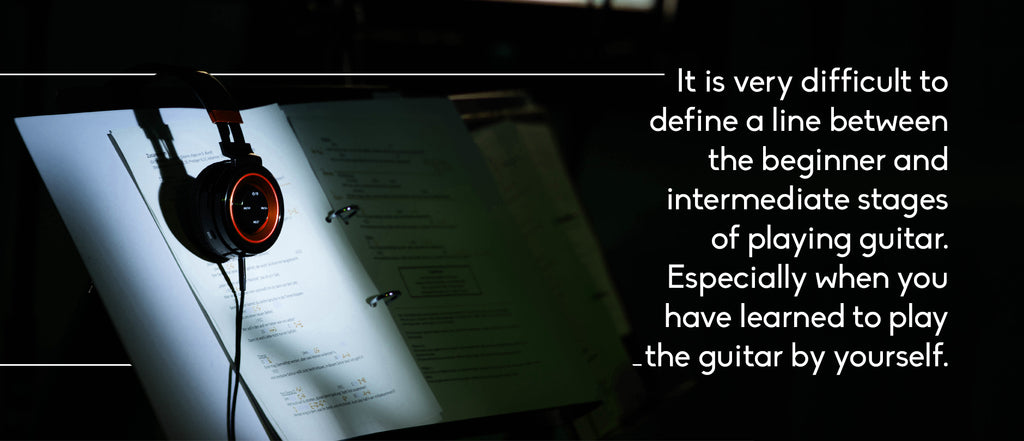
Why Use Guitar Picks?
Guitar Picks have different advantages when comparing them with fingers.
Guitar picks help increase your playing speed, produce a louder, brighter sound than fingers, and can be shaped to achieve better results when using different techniques like strumming or palm mute.

In general, plectrum techniques are easier to master than classical fingerstyle, or hybrid. It is easier to play fast picked notes.
As a beginner, this is very motivating, since your process of learning will be accelerated.
Guitar Picks - Quick Guide:
At the very beginning of your guitar learning process, your feeling of sound and feedback provided by a guitar pick as not yet developed.
Therefore, you should consider only these two attributes of a guitar pick:
- Guitar Pick Thickness
- Guitar Pick Shape.
Simplifying the “science” of a guitar pick will help you make a fast choice without spending too much time and stress.
After your first couple of months playing guitar, you will develop new skills, which will allow you to introduce more complex factors to your final decision of which pick to buy, guitar pick material, guitar pick size, and other special features.
If you feel secure enough to understand these additional features of a plectrum, go to our guide: How to choose the right guitar pick, which you can find HERE.
For the thickness and the shape, here is where you should begin:
0,75 mm Guitar Picks: The Best Choice for Beginner Guitar Players
Light guitar picks with less than 0,6 mm are considered beginners’ guitar picks.
The reason for this, is that most beginner guitar players first learn strumming techniques, which can usually be played better with thinner plectrums.
However, medium guitar picks with 0,75 mm thickness are the best place to start.

Plectrums with medium thickness are the most versatile in terms of tone, and can be used for rhythm and lead guitar.
If you are having fun with strumming exercises, medium thickness will perform well. If you need to practice some lead guitar techniques, it will work as well.
Depending on the kind of guitarist you want to become, you may consider moving to a higher or lower thickness range afterward.

Rombo Origami is a good example of a medium thickness guitar pick.
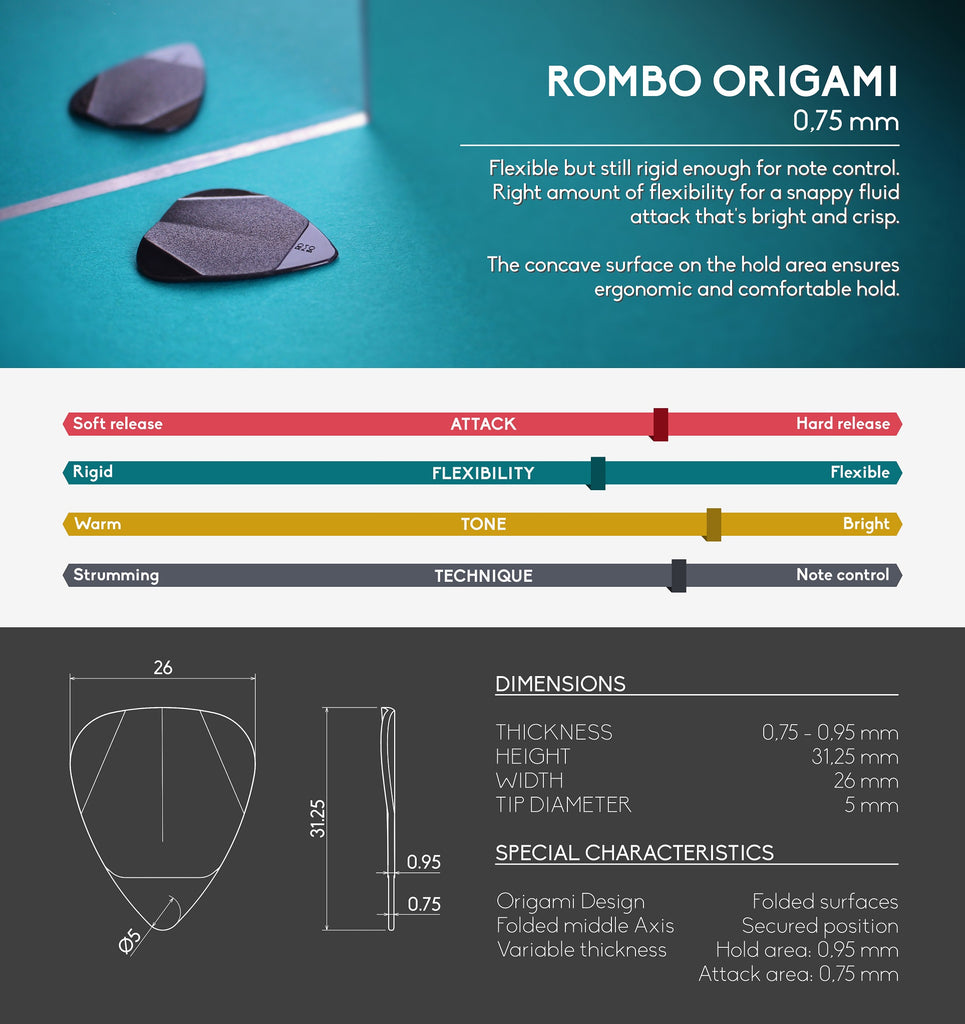
Teardrop Shape and Standard Shape Guitar Picks: The Best Choice for Beginner Guitar Players
Teardrop shape and standard shape guitar picks are simply the most common shapes for plectrums, and globally famous by every single guitar player.
You cannot go wrong if you use one of these shapes for your first guitar pick.
Both picks have enough surface for a solid grip, and the tip has mostly a medium radius, and often even a light bevel edge for smoother playing.
When is it time to change the guitar pick?
I am not talking about wear and tear. For this, we already published the article “Guitar Pick Durability”
What I really mean is, when is it time to question the guitar pick model you are using and use a different thickness or a different material?
Avoid sticking with a single guitar pick model for the rest of your life.
Using different guitar picks will give you the possibility to increase your tonality ranges, develop a more accurate feeling for different guitar techniques, and be more aware of your preferences when it comes to guitar gear.
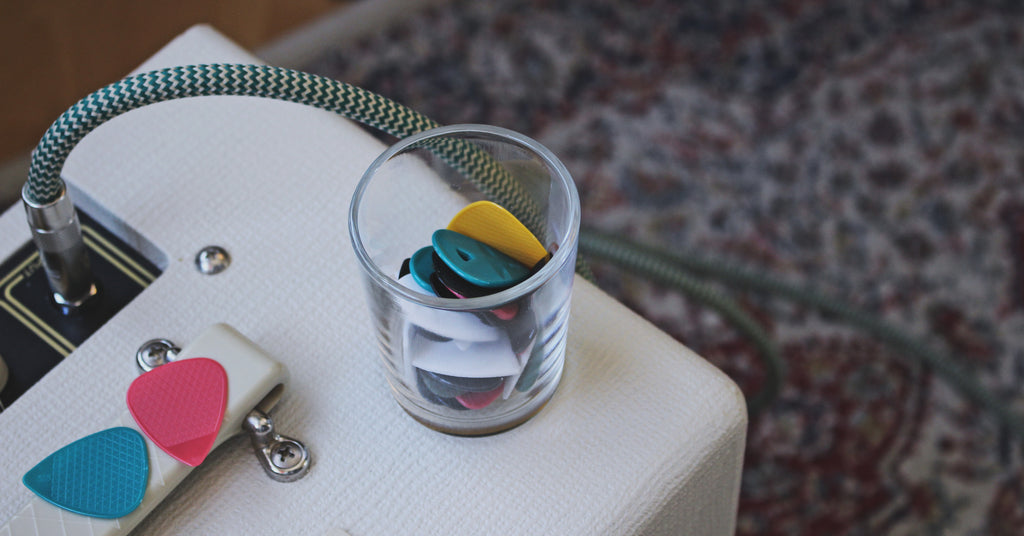
Therefore, the answer is: always! I cannot recommend enough, the benefit of testing as many different plectrums as possible, and then decide which ones are your favorites.
I used the plural noun “favorites”, because you should find at least 3 of your top guitar picks.

As you develop your skills as a guitarist, you will notice that some guitar pick shapes, or guitar pick thicknesses, are more adequate for specific techniques.
Discover our variety pack HERE
In my case, I like medium picks for strumming, hard ponty guitar picks for practicing scales and loud music, and very rounded guitar picks for the days I just want to relax, use my reverb pedal, and create beautiful clean guitar melodies.
Conclusion: The Right Guitar Pick For Beginners
An important part of learning guitar, is knowing the gear you use: The amplifiers, the pickups, the different guitar strings, the guitar pedals, and also the guitar picks.
Don’t feel overwhelmed by the amount of guitar picks out there. It’s just a matter of preference, and you will have to spend some time trying new guitar picks, which can be fun and bring you some nice experiences.
You can start with a standard shaped guitar pick with 0,75 mm thickness. But, if you don’t feel comfortable with just one option, try a variety pack, containing some different guitar picks. Close your eyes, and chose the guitar pick that feels right to you.
Please leave a comment and tell us the thickness of the first guitar pick you had. Thanks!

7 Easy Warm-Ups Every Guitar Player Should Know
As a guitarist, the best way to start every practice session is by warming up.
In addition, integrating different techniques will immediately improve your skills and will prevent injuries.

Whether you are planning a studio session, a jam with your friends, or some solo relax sessions at home, a conscious warm-up before playing guitar is mandatory. No matter if you use guitar picks or play with the fingers, there are no excuses.

This 7-step warm-up will help bring your playing to peak level. Developing the habit of warming up your hands and upper body will improve your posture and make your playing look “easy” and relaxed.
1- Don’t Play Guitar with Cold Hands
Cold hands make guitar playing very difficult.
You will notice this during your first guitar chords. Your fingers and hands won’t be agile enough to play your guitar and you will struggle holding your guitar pick.
Running your hands under warm water is the fastest way to get the temperature your fingers need to improve the blood circulation.
Combine it with the step 2 and get the best results.

2- Massage your Hands before Playing Guitar
When it comes to guitar, our hands are our most precious tools.
The hand muscles tend to tighten up. In order to loosen them, you can do a hand massage.
Some musicians may hit a plateau or wall in terms of their speed or dexterity, because by not taking care of their hands properly, the muscles of the hand and fingers are tighter and less supple. It seems a no-brainer.
If you rely on your hands for your income/career, you want to do what it takes to keep them as healthy as possible.
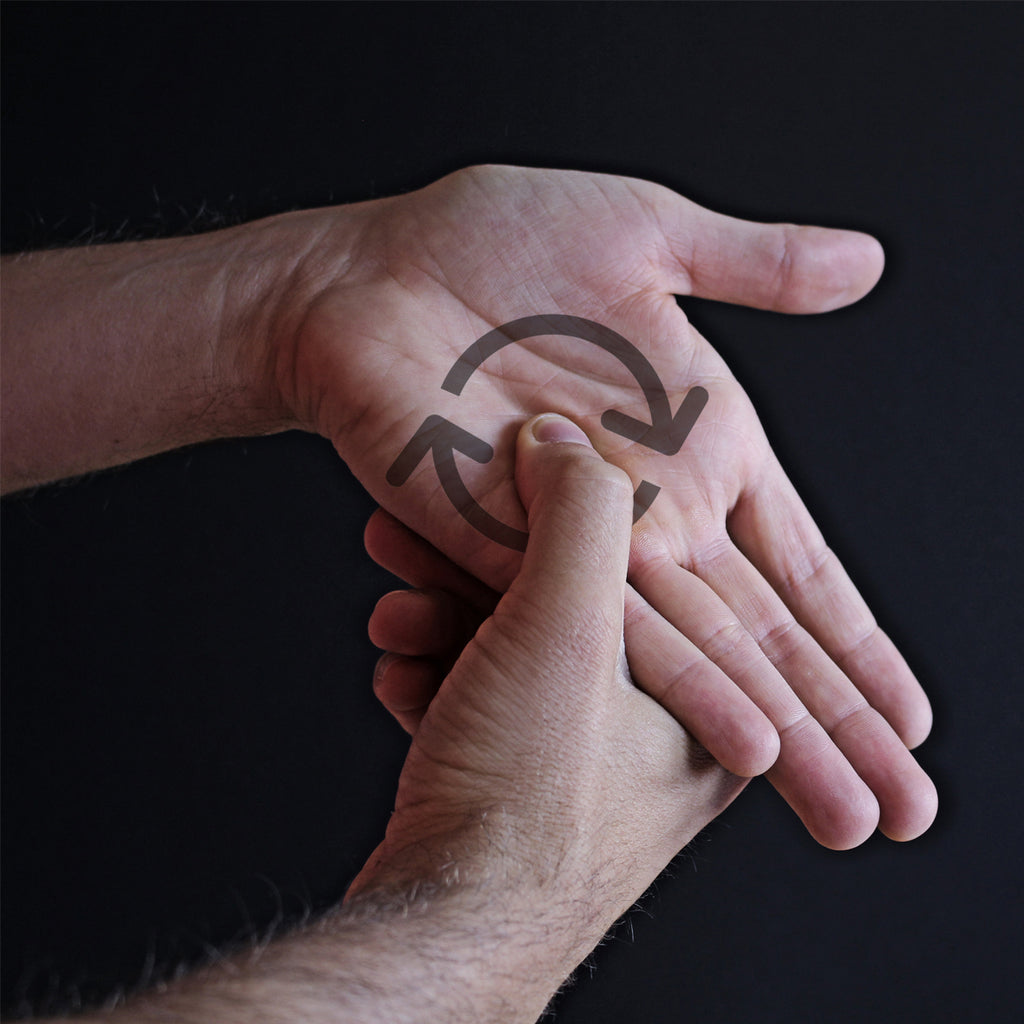
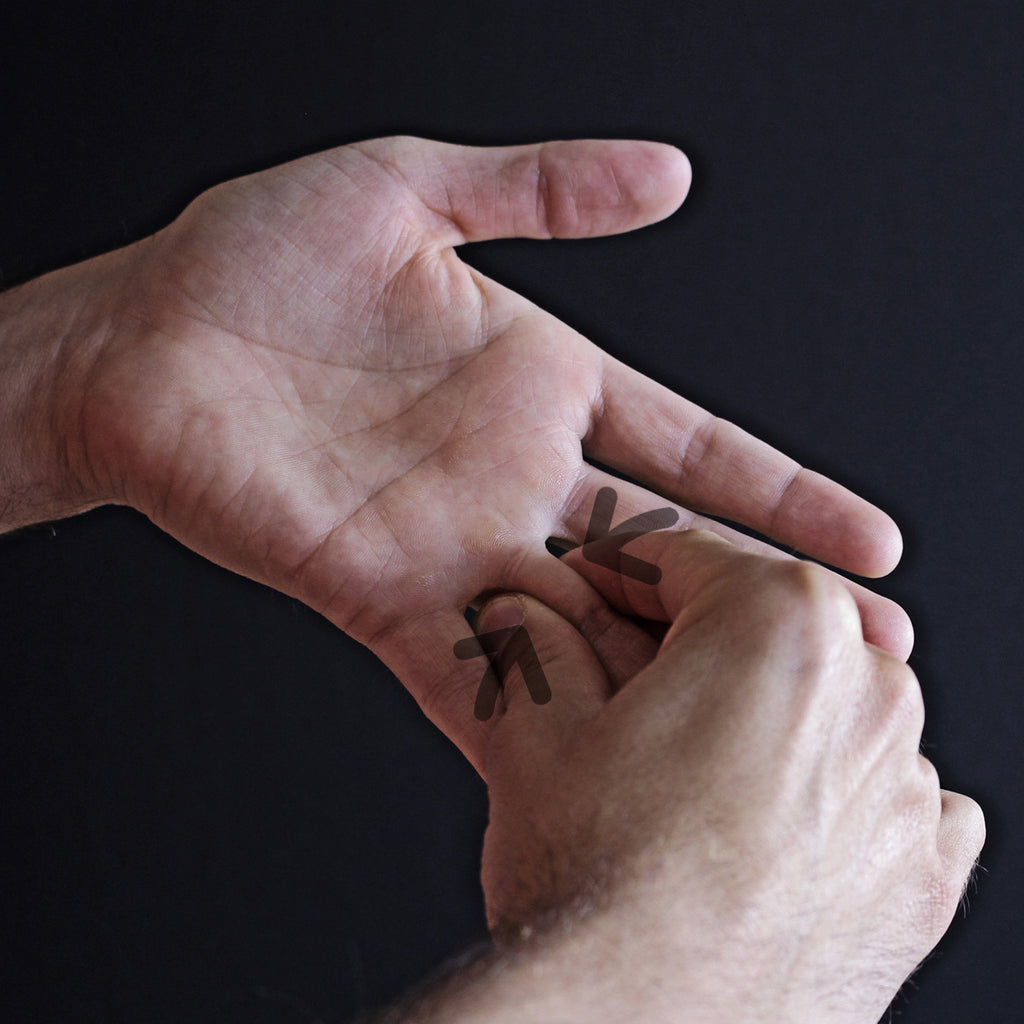

A proper holding of your guitar pick is necessary to avoid pain. Do you know how to hold your guitar pick the right way? Click HERE and learn more.
3 -Shake your Arms, Hands and Body
Every muscle is connected. Your hands, wrists, forearms, shoulders and back should all be performing their best during your practice.
To get the blood flowing through your body, simply move your arms and legs, shake your arms and back, and then make a fist, opening and closing your hands at least 10 times.
This exercise will not only prepare your hands, but will also relax your body and help to get the preparation you need before playing your guitar.
4- Use a Ball and squeeze It
A ball is an excellent way to warm up your hands before you practice guitar.
If you implement this in your routine, you will be able to do every exercise quickly, in just a few days.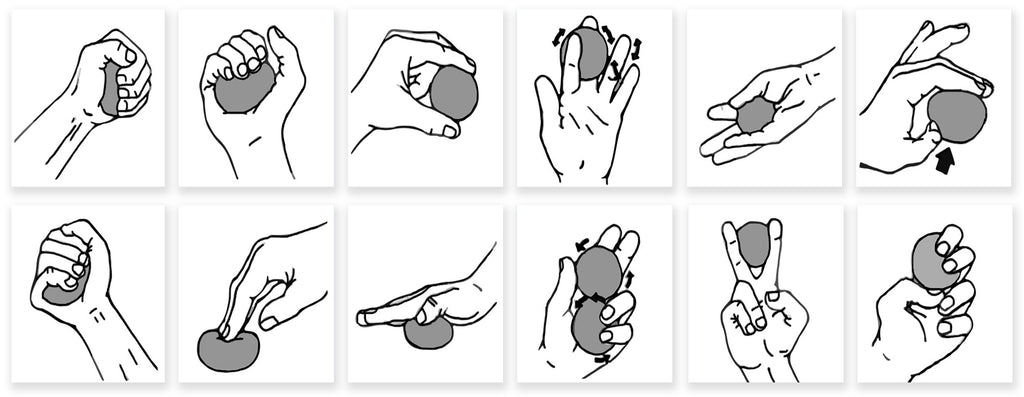
This method was mentioned in the article “Play Guitar Faster - Guitar Methods for Speed Playing”, which you can find HERE.
5 - Stretch your Fingers
The last thing to do, before moving on to playing your guitar, is to lightly stretch your fingers.
Stretching your fingers helps to enhance flexibility. It lengthens tight muscles and prevents injuries.

Playing guitar can cause fatigue to these areas, and stretching helps to keep the muscles loose and limber. It increases flexibility, and your range of motion.
Stretching your fingers before playing guitar will warm up muscle tissues and joints.
6- Play Something that is not emanding for your current Guitar Skills.
Try playing some simple exercises, melodies and/or chord progression.
Here some ideas you can use for your routine:
- Simple scales, such as the minor pentatonic scale.
- Riffs or songs you already know
- Technical exercises you already master (For both hands).
- Picking patterns – either fingerstyle or with a guitar pick

If you are using a guitar pick, you might have to practice some specific techniques depending on your music style. If you are not sure which guitar pick is the right one for you, check this guide HERE.
If your hand is still sore, repeat some of the steps. Especially in the winter months, as the hands can get cold very fast.
7- Take a Minute to concentrate and focus Yourself
Some guitar players keep playing the stuff they already know, and have given up practicing to improve.
Try to be focused on your role, and separate the habit of playing for fun or relaxing, from the habit of playing guitar for improving.

Take a minute, breathe, think about the next 90 minutes, and focus on the guitar.
Now you can avoid Guitar Playing Injuries, and improve your skills:
While playing guitar you are moving your muscles to make a specific, complex series of movements and hand positions.
With cold muscles and no time to adapt to your exercises, your hand tissues can develop micro-tears that lead to injuries or pain.
But that is not all, it is proven that the right warm-up will immediately improve skills like guitar speed, precision, concentration, and resistance.
Bonus Track: Take a Break!
Some guitarists play for hours.
If you are one of those ambitious musicians, trying to become one of the best 5% of guitar players, you need to take enough breaks and relax the muscles. 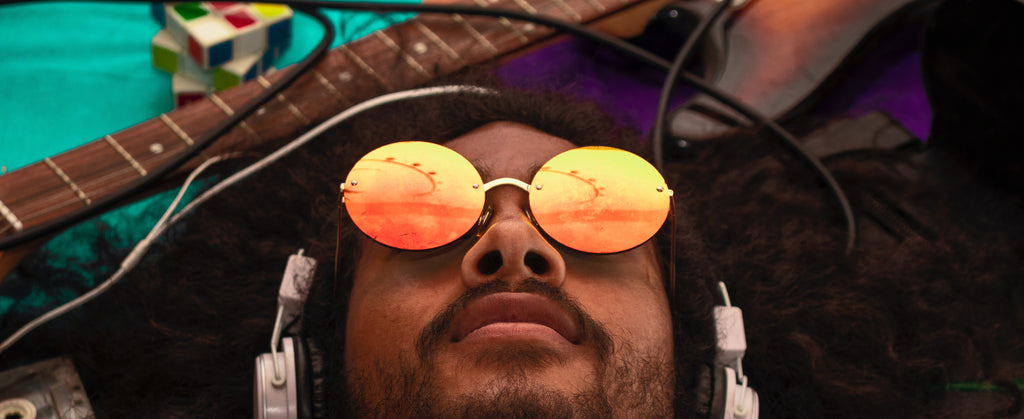
Stand up every 60 minutes and repeat some of the mentioned exercises. The best way to do so is to set an alarm and be disciplined enough to stop your training, when the alarm goes off.
Leave a comment and tell us if this is useful!
Thanks!
- Shop
- Dealers
- Legal Notice
- Terms of Service
- Refund Policy
- Shipping
- Privacy Policy
- Contact us
- Press
- FAQ
Sign up to get the latest on sales, new releases and more…
By signing up you agree to our privacy policy.
© 2024 ROMBO.
registered brand
Powered by Shopify


